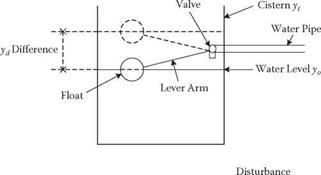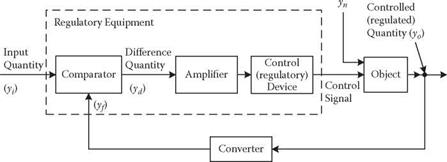In open control, the control equipment is not affected by the object or process. Certain types of control equipment in central heating systems are examples of open control (see Figure 2.9). The control equipment has the job of reducing the temperature in the water used for heating at night, according to a preset programme. The measuring device, for example, senses by means of electrical contacts switched on or off by pegs from the control device, the stage in the programme that has been reached. The contacts ‘inform’ the central link, which processes the information. After processing, certain of the input conditions given by the measuring device will result in a command to the control device (for example, to start valve motor 1). Note that no signal from the process/control object affects the control equipment.
It is very difficult using open control to maintain the actual value at the set value. This can only happen when the object is not exposed to any external disturbances, or where these are well known and can be taken into account in advance. Where these conditions are not met, large deviations from the desired values must be allowable in order for open control to be used.
Closed control (see Figure 2.10) has a system where the output signal (actual value) is fed back to the input signal (desired value) and compared with it. The input signal is, in certain cases, the desired output signal. When this required actual value, the desired value, is compared with the true value fed back, a difference results if the actual value deviates from the set (desired) value. After amplification via the control device, this deviation then goes in as the control quantity to control the process or object.
|
Disturbance Quantity
FIGURE 2.9 Open control: Note that there is no feedback from the output of the controlled object to the controller, but only within the controller itself. Changes in the controlled quantity thus cannot affect the control equipment. |
|
FIGURE 2.10 Closed-loop control, also known as regulation. The regulated quantity affects the controlling signal. |
The controlled system is also affected by external disturbances (yn). The signal (yO) goes out from the system, is measured, and fed back.
When the comparison between the input (y) and the feedback signal is an additive, this is known as positive feedback. This type of feedback, which gives an accelerating change of the output signal, is used, for example, to achieve the fastest possible changes of output signal. When the comparison between y and yO is subtractive, we have negative feedback. This means that yd (difference quantity) decreases when the output yO increases, and thus attempts to stop yO rising. Negative feedback is the most common form of feedback. One well-known example of a control mechanism with negative feedback is the regulation of the water level in a WC cistern by a ball-cock valve. Figure 2.11 shows a diagram of a cistern with its ball-cock valve and the corresponding signal control diagram (a block diagram).
A distinction may be made between closed control systems,[3] which only have to compensate for outside disturbances and not for changing inputs, and closed control systems which are not exposed to outside influences but which only attempt to follow changes in input quantity. The first type of regulation system (where the input value is not changed) is known as constant regulation. The second type, with variable inputs, is known as servo-regulating. A servo-regulating system only has the task of trying to achieve an output that follows as closely as possible the varying input level. The WC cistern described above is an example of constant regulation, which tries to keep the output (in this case, the water level) constant regardless of outside disturbances (that is, the water being flushed out of the cistern). Most regulation systems in process industries function as constant regulation systems (where the set value can be changed). At start-up, however, a certain degree of servo-regulation takes place.
![]()

|






